http://www.rhci-online.net/radiogram/radiogram.htm
http://www.rhci-online.net/radiogram/radiogram.htm
|
RSID: <<2018-08-15T20:25Z MFSK-32 @ 6070000+1500>>
START IBC - ITALIAN BROADCASTING CORPORATION
mail: ibc@europe.com
"IBC DIGITAL"
Sending Pic:190x350C;
|
|

|
|
|
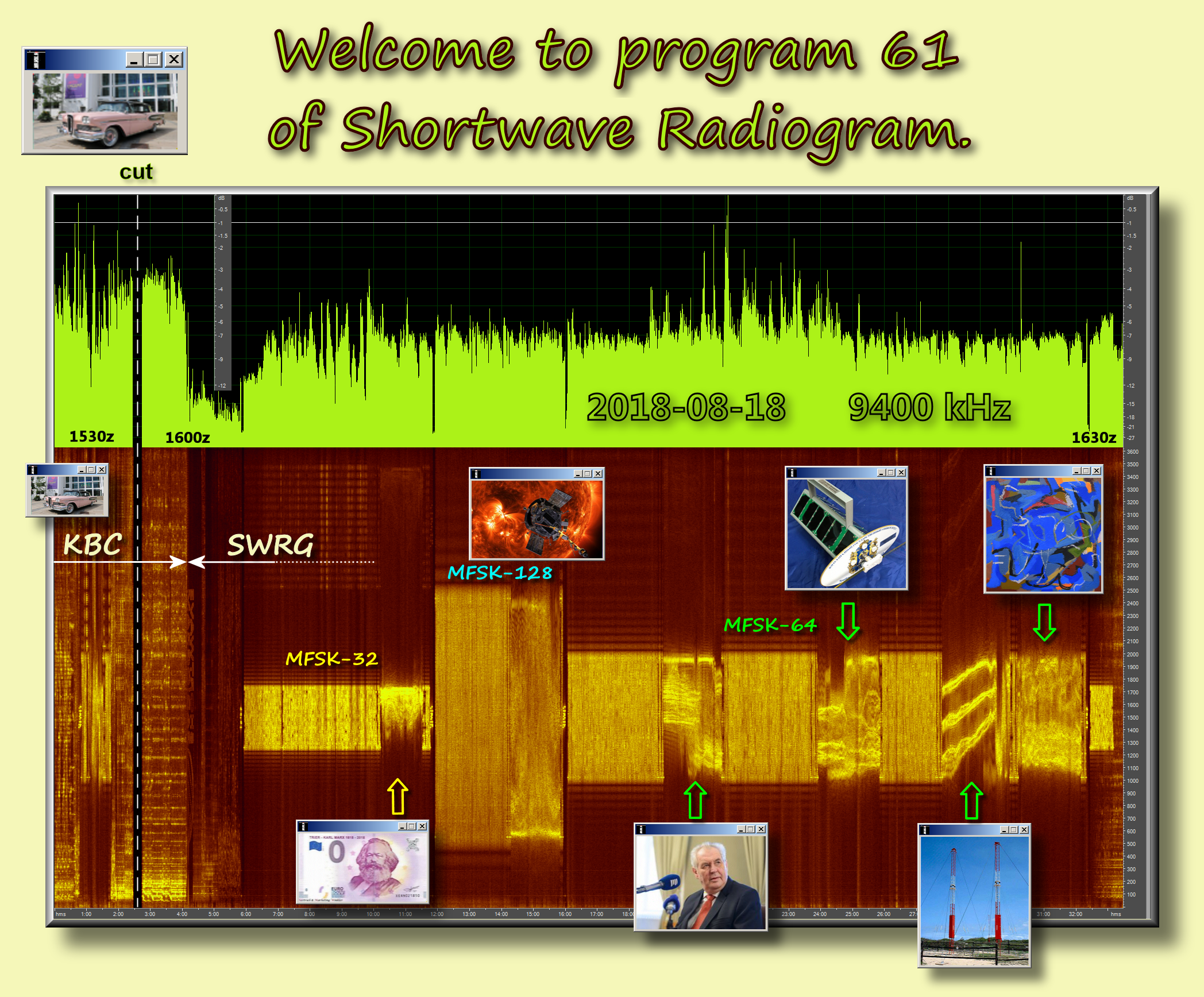
RSID: <<2018-08-18T16:01Z MFSK-32 @ 9400000+1500>>
Welcome to program 61 of Shortwave Radiogram.
I'm Kim Andrew Elliott in Arlington, Virginia USA.
Here is the lineup for today's program, in MFSK modes as noted:
1:40 Program preview (now)
3:00 "Zero euro" bills with Karl Marx's image*
7:38 MFSK128: Parker Solar Probe will travel close to sun*
11:47 MFSK64: Czech politics of invasion 50th anniversary*
16:49 Russian cosmonauts' eight-hour spacewalk from ISS*
21:46 Budget cuts might shut down WWV and WWVH*
25:51 Painting of the week*
28:10 MFSK32: Closing announcements
* with image
Please send reception reports to
radiogram@verizon.net
And visit http://swradiogram.net
Twitter:
@SWRadiogram
From Deutsche Welle:
Tourists snap up 'zero euro' bills with Karl Marx's image
Karl Marx-themed mugs, stickers,
magnets and pens do well at
the tourism office in the German city
of Trier. But a new
item, released earlier this year to
mark the philosopher's
200th birthday, is the really big
hit.
Dagmar Breitenbach
15 August 2018
More than 100,000 'zero euro' bills printed with the image of
capitalism critic Karl Marx have been sold since the souvenir was
introduced in commemoration of the German philosopher's 200th
birthday, says Hans-Albert Becker of the Trier tourism bureau, in
western Germany.
It's become a brisk business for the city, where Marx was born on
May 5, 1818: the popular souvenirs cost 3 (real) euros ($3.41)
apiece.
Prized possessions
And tourists from all over the world have been snapping them up,
in Trier and online, Becker told Germany's dpa press agency,
adding that the bill has surprisingly become a major seller. "We
never expected the bills to be such a success."
The purple bank note looks and feels real: it has just about the
right size, is printed on security paper, and has all the right
security features, including a water mark, copper stripes,
hologram, UV fluorescent ink and an individual serial number.
Asians seem to be particularly taken by the fake bill, says
Becker. "25,000 to 30,000 alone must have gone to China," he
said.
Trier in a Marx frenzy
This year, it's all about Karl Marx, the famous author of Das
Capital, also known as Capital, Critique of Political Economy, in
his hometown Trier. Souvenirs with the image of a bearded Marx
beckon at every corner, from t-shirts and posters to mugs, pens,
books, posters and cookie cutters. Four museums have dedicated
exhibitions to the city's famous son.
https://www.dw.com/en/parker-solar-probe-diving-into-the-solar-atmosphere/a-45016296
|
====> https://www.dw.com/en/tourists-snap-up-zero-euro-bills-with-karl-marxs-image/a-45089015
|
Sending Pic:223x119C;

Shortwave Radiogram now changes to MFSK128 ...
RSID: <<2018-08-18T16:07Z MFSK-128 @ 9400000+1500>>
This is Shortwave Radiogram in MFSK128
Please send reception reports to
radiogram@verizon.net
From Deutsche Welle:
Parker Solar Probe: Diving into the solar atmosphere
The Parker Solar Probe is designed to
unveil a great secret
of the sun. To do so, it must travel
closer to our star than
any other spacecraft before it to
collect data in a hellish
environment.
Cornelia Borrmann
9 August 2018
For decades, solar researchers have been searching for an
explanation for a mysterious phenomenon: how is it possible that
the atmosphere of the sun is up to five hundred times hotter than
its surface? In the atmosphere around the sun, known as the Sun's
'corona,' temperatures of several million degrees Celsius
prevail. But the visible surface below it, from which the corona
gets its heat, is only about 5800 degrees.
The incredible, unparalleled heat of the corona is a central
question in solar physics. Scientists suspect the underlying
mechanism probably also holds relevance for the formation of the
so-called solar winds.
Hellish conditions
Our Sun is a glowing hot ball of gas from which matter constantly
escapes into space - this is known as 'solar wind.' It flows out
of the hot corona, and consists mainly of ionized hydrogen,
electrons and protons.
This electrically charged particle stream also blows toward the
Earth, where it meets the Earth's magnetic field. It acts as a
protective shield and, for the most part, keeps the particle
shower away from our planet.
Explosive processes in the Sun, such as coronary mass ejections
and sudden radiation bursts - called 'flares' - can cause
turbulence and transform the uniformly flowing solar wind into a
storm.
With a flare, the intensity of 'x-rays' often increases by more
than a thousand times. Those are high-energy protons and
electrons. That radiation reaches us unhindered after just eight
minutes. While the particle streams reach Earth 10 to 30 minutes
later.
In a coronary mass ejection, the Sun hurls huge clouds of
electrically charged gas into space. These clouds can have a mass
of several tens of billions of t aTa5each a speed of over
2000 kilometers per second!
The explosive mass ejections cause shock waves within the
constantly flowing solar wind, comparable to the supersonic bang
of an aircraft.
Earth in the line of fire
If these shock waves hit Earth, the particles from the Sun can
overcome Earth's protective shield with their powerful speed,
penetrating its magnetic field.
This means strong solar storms can cause enormous damage. They
influence the structure of electromagnetic waves and interfere
with mobile radio and satellite navigation.
On March 13th, 1989, a nine-hour power outage occurred in Quebec,
Canada. Millions of people were without electricity. A violent
solar storm had induced strong currents in the overhead lines and
caj90 ľrmers to burn through.
The electrically charged particles from the sun can decelerate
satellites and even shorten their lifetime by destroying
electronic components.
Electronics and satellite technologies are playing an
increasingly important role in our lives. Now more than ever,
it's important to predict such solar storms. But before this can
be done, the researchers must understand how solar storms form.
Space probe to unveil secrets
It is hoped the Parker Solar Probe can fill the gaps in our
understanding; showing us how the solar atmosphere is heated and
how the particles of the solar wind are accelerated.
Solar physicists have already developed different theories in
answer to these questions. Only in March this year an
international team led by Samuel D.T. Grant published anarticle
in the renowned journal "Nature Physics".
In this paper, the researchers propose that the heating takes
place via plasma waves in the transition layer between the
surface and the corona of the sun. Other theories attribute the
heating of the corona to processes in the Sun's magnetic field,
such as the sudden fusion of magnetic field loops.
The Parker Solar Probe is designed to collect data for the first
time in the region where the solar wind is generated. To do this,
the satellite must approach our central star like no other probe
before it. The spaceship has to dive into the corona of the sun
and get as close as six million kilometers to the fiery red-hot
ball of gas.
Long journey to the sun
For decades, solar physicists have dreamt about sending
satellites into the corona of the sun. In 1958, the year NASA was
founded, such a mission was put on the agenda. But it would be
decades before the necessary technologies were developed to
protect the space probes from the extreme radiation and the
enormous heat in the solar corona.
It will be a few more years before the Parker Solar Probe can
explore this hellish region at close range. The probe's success
is contingent on the help of Venus. After all, braking is not
easy when flying a spaceship into the inner solar system.
Therefore, the research probe must fly past Venus seven times.
During each of these so-called 'swing-by' maneuvers, it transfers
some energy to the planet. It slows down, changes its course and
continues to advance towards the sun.
After the last fly-by in November 2024, the Parker Solar Probe
will finally reach the speed at which it can approach the Sun by
only six million kilometres. It will then fly through the solar
atmosphere at a speed of 200 kilometres per second. That's
approximately 30 times faster than the speed at which the
International Space Station currently travels through space. With
its four scientific instruments, it is to measure the particles
buzzing around and the magnetic fields of our star.
Three times, the spacecraft is scheduled to fly into the vicinity
of the Sun and give us completely new insights into its turbulent
processes. The Parker Solar Probe will be the fastest spaceship
ever launched by humans.
https://www.dw.com/en/parker-solar-probe-diving-into-the-solar-atmosphere/a-45016296
Image: Depiction of the Parker Solar Probe diving into the solar
the solar atmosphere ...
Sending Pic:228x135C;
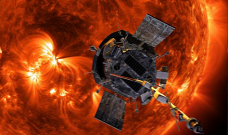
Shortwave Radiogram now changes to MFSK64 ...
RSID: <<2018-08-18T16:11Z MFSK-64 @ 9400000+1500>>
This is Shortwave Radiogram in MFSK64
Please send reception reports to
radiogram@verizon.net
From Radio Prague:
Anniversary of 1968 invasion spotlights present-day concerns
about domestic, foreign policy
Daniela Lazarová
16 August 2018
The upcoming 50th anniversary
of the Soviet-led invasion of
Czechoslovakia has sparked
controversy on the Czech
political scene. Right-wing
parties see the anniversary as
an opportunity to protest
against what they see as President
Zeman's pro-Russian orientation
and the fact that the
Communist Party is regaining an
influence on national
politics, while the Communist
Party, which faces renewed
hostility on the anniversary,
is trying to play down
Russia's responsibility for the
invasion.
As Czechs prepare to mark one of the darkest chapters of the
country's history, politicians are engaged in a war of words that
has little to do with the past. Right-of- centre parties see the
anniversary predominantly as a warning against allowing the
Communist Party to regain political influence, which they have
achieved by supporting the Babiš-led government of ANO and the
Social Democrats, and what they see as President Zeman's
pro-Russian orientation.
The news that President Zeman would not be making any kind of
speech to mark 50 years since the Soviet-led invasion, has
elicited sharp criticism from many sides. The head of the right
wing TOP 09 party Jirí Pospíšil sent the president an open letter
urging him to do his duty as head of state by marking an
anniversary that had a hugely detrimental impact on the country's
history – hundreds of dead, hundreds of thousands of migrants who
fled the country after the invasion and hundreds of thousands of
others who lost their jobs because they refused to sign petitions
approving the invasion.
Who other than the president should make a speech on this dark
anniversary – the head of the Pirates Party Ivan Bartoš echoed.
Civic Democrat leader Petr Fiala tweeted that the president's
decision to remain silent was "strange" and reflected ill on him
alone. Social Democrat Jan Chvojka noted that the invasion was a
milestone of such importance that it merited a few words from all
political leaders.
The president's spokesman Jirí Ovcácek reacted on Twitter by
saying that President Zeman had had the courage to speak out
against the invasion when many were silent and had been thrown
out of work as a result. The president still sees the invasion as
criminal, but he spoke out when it mattered and he sees no reason
to address the occupation 50 years after, Ovcácek said.
Meanwhile, Communist Party leader Vojtech Filip added fuel to the
fire by saying in a recent interview for the Guardian that
history was being falsified based on the position against Russia.
He argued that then-Soviet leader Leonid Brezhnev was from
Ukraine and the major force of the invading armies were
Ukrainian.
Prime Minister Andrej Babiš, who after failing to put together a
majority coalition, opted to lean on Communist Party supporteit
repeatedly argued that the Communist Party's position was
legitimized by voters themselves. He stopped short of defending
the party leader when asked to comment on the interview for the
Guardian.
"The invasion was a terrible tragedy for the whole nation. It was
organized by the Soviet Union and it must be condemned" Babiš
said. He said that he and the heads of the lower and upper
chambers of Parliament would be speaking at the wreath-laying
ceremony outside Czech Radio on August 21st to pay homage to the
h of this tragedy.
https://www.radio.cz/en/section/curraffrs/anniversary-of-1968-invasion-spotlights-present-day-concerns-about-domestic-foreign-policy
Image: Czech president Miloš Zeman ...
Sending Pic:225x162C;
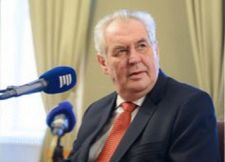
This is Shortwave Radiogram.
Please send reception reports to
radiogram@verizon.net
From Radio Free Europe/Radio Liberty:
Russian Cosmonauts Set Up Animal-Tracking System In Eight-Hour
Spacewalk
16 August 2018
Two Russian cosmonauts on August 15 spent nearly eight hours on a
spacewalk setting up an antenna for tracking birds and animals on
Earth and sending a series of tiny satellites flying into orbit.
Sergei Prokopyev used his gloved right hand to fling four
research satellites into space. The first minisatellite safely
tumbled away from the International Space Station as it soared
400 kilometers above the U.S. state of Illinois.
By the time the fourth satellite was launched 14 minutes later,
the station had flown thousands of kilometers to the east and was
close to Spain. Two of the satellites were only the size of
tissue boxes.
Prokopyev and Oleg Artemyev spent the next several hours
installing the antenna for a German-led animal-tracking project
known as Icarus, short for International Cooperation for Animal
Research Using Space.
The cosmonauts had to unreel, drag, and connect long, white
cables to provide power and data to the system. At one point,
Artemyev had to pull out a sharp knife to deal with a twisted
cable.
"Can you give us some more difficult tasks, please?" Artemyev
joked as he routed the cables, a long and tedious chore that
ended up lasting nearly an hour longer than anticipated.
A spokesman for NASA, the U.S. space agency, said the cosmonauts
were in "great shape" after completing all their tasks.
The spacewalk on August 15 was the 212th from the International
Space Station, and the seventh this year, NASA said. The station,
run jointly by Russia and the United States, was launched 20
years ago at a time of much lower tensions between the countries.
The spacewalk was the first for Prokopyev since he arrived at the
station in June for a half-year mission. It is the third for
Artemyev, who increase5iažspacewalk time to 20 hours and
20 minutes.
Most of the scientific research performed on the station would be
impossible to do on Earth.
The station n ideal place for an animal-tracking antenna,
compared with other orbiting satellites, said project director
Martin Wikelski of the Max Planck Institute for Ornithology in
Germany.
That's because spacewalkers are on hand to fix anything that
breaks and the computers on the station are better protected from
space radiation, he said.
The project will start out tracking blackbirds and turtle doves
already outfitted with small global positioning system (GPS)
tags, then move on to other songbirds, fruit bats, and bigger
wildlife.
Wikelski said researchers had ear tags for big mammals like
gazelle, jaguars, camels, and elephants, as well as leg-band tags
for larger birds such as storks. The tags are easy to wear and
should not bother the animals, he said.
Wikelski watched the spacewalk from Russian Mission Control
outside Moscow. He said researchers can better understand animal
behavior through lifelong monitoring. Among the things they hope
to learn: where the animals migrate, and how they grow up and
manage to survive.
"We also learn where, when, and why they die," he explained in an
e-mail to the Associated Press, "so we can protect our wild
pets."
The space station is also home to three Americans and one German
astronaut. They are planning to conduct two spacewalks next
month.
With reporting by AP and dpa
https://www.rferl.org/a/russian-cosmonauts-set-up-animal-tracking-system-8-hour-spacewalk-iss/29436575.html
Image: A Tanyusha-YuZGU satellite of the type "tossed" by the
cosmonauts during their spacewalk ...
Sending Pic:206x189C;

This is Shortwave Radiogram
Please send reception reports to
radiogram@verizon.net
From ARRL.org:
NIST FY 2019 Budget Would Eliminate WWV and WWVH
11 August 2018
The National Institute of Standards and Technology (NIST) FY 2019
budget request includes shutting down "NIST radio stations in
Colorado and Hawaii" - in other words, WWV and WWVH. Radio
amateurs, HF listeners, and others around the world routinely
make use of the time and frequency standard signals, which also
include propagation information. NIST said eliminating funding
currently "supporting fundamental measurement dissemination"
would include putting WWV and WWVH off the air for a saving of
$6.3 million. The NIST FY 2019 budget request for efforts related
to Fundamental Measurement, Quantum Science and Measurement
Dissemination is $127 million, which, the agency said, is a net
decrease of $49 million from FY 2018 levels. The Administration's
overall NIST budget request is more than $629 million.
"The proposed reductions will allow NIST to consolidate and focus
on narrower core [fundamental] measurement programs while meeting
budget levels," the agency said in its FY 2019 budget summary.
"NIST will focus on basic research while reducing funding for
efforts applying some of its breakthroughs into new measurement
applications.
The FY 2019 proposed budget cuts developed earlier this year came
to light via Tom Witherspoon, K4SWL, who maintains The SWLing
Post website, after a number of viewers called it to his
attention. He posted an article on his blog.
"I've always considered WWV and WWVH to be the heartbeat of the
shortwaves here in North America - a constant, timely companion
and brilliant gauge of HF propagation," Witherspoon wrote. I
assumed both stations would be some of the last to go silent on
the shortwaves." ...
"I find this budget request very disappointing," Witherspoon said
with respect to the proposed elimination of WWV and WWVH. "Let's
hope, somehow, this does not come to fruition." He said The
SWLing Post would be tracking and posting any new developments.
http://www.arrl.org/news/nist-fy-2019-budget-would-eliminate-wwv-and-wwvh
Image: The 15 MHz antenna array at WWVH in Hawaii ...
Sending Pic:189x224C;
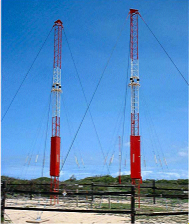
Our painting of the week is by Bill Philipovich. From
bit.ly/2MsHRv6 ...
Sending Pic:200x198C;
Shortwave Radiogram now returns to MFSK32 ...
RSID: <<2018-08-18T16:28Z
MFSK-32 @
9400000+1500>>
This is Shortwave Radiogram in MFSK32 ...
Transmission of Shortwave Radiogram is provided by:
WRMI, Radio Miami International, http://wrmi.net
and
Space Line, Bulgaria, http://spaceline.bg
Please send reception reports to
radiogram@verizon.net
And visit http://swradiogram.net
Twitter:
@SWRadiogram
I'm Kim Elliott. Please join us for the next Shortwave
Radiogram.
http://www.rhci-online.net/radiogram/radiogram.htm
|
QTH: |
D-06193 Petersberg (Germany/Germania) |
|
|
Ant.: |
Dipol for 40m-Band & Boomerang Antenna 11m-Band |
|
|
RX for RF: |
FRG-100B + IF-mixer & ICOM IC-R75 + IF-mixer |
|
|
Software IF: |
con STUDIO1 - Software italiano per SDR [S-AM-USB/LSB] + HDSDR 2.76 stable [2017-02-02] - for scheduled IF-recording |
|
|
Software AF: |
Fldigi-4.00.12 + flmsg-4.0.3 images-fldigifiles on homedrive.lnk |
|
|
OS: |
German XP-SP3 with support for asian languages |
German W7 32bit + 64bit |
|
PC: |
MEDION Titanium 8008 (since 2003) [ P4 - 2,6 GHz] |
MSI-CR70-2MP345W7 (since2014) [i5 -P3560 ( 2 x 2,6GHz) ] |
RSID: <<2018-08-15T18:28Z
MFSK-64 @
6070000+1500>>
We won't have much spoken word in today's episode. Today's show is full of SSTV
and data.
You will need Fldigi or something similar to decode the data, and in addition to
that a program like MMSSTV or QSSTV or an app like Robot 36 if you are an
Android person or CQ SSTV for iOS.
You can find more info on that on our website, which is slowscanradio.com
slowscanradio.com
We would appreciate your reports very much. I have a bit of a backlash resonding
to your reports, although I did respond to several of you but this week we have
our new QSL-card ready, which by the way is only available digitally as a pdf. I
already have to send
around 200 of them. So pleas be patient.
Reports still are much appreciated at our mail address x@xdv.me x@xdv.me, which
is also on our website.
We will start now with a digital version of the text you just heard, in MFSK64.
All data today is at 1500 Hz. MFSK64 and all data will be 1500 Hz.
de k
RSID: <<2018-08-15T18:29Z
MFSK-64 @
6070000+1500>>
PD90
PD50
PD50
PD50
PD120
PD180
PD120
PD90
PD50
PD50
PD50
PD180
After this data
de k

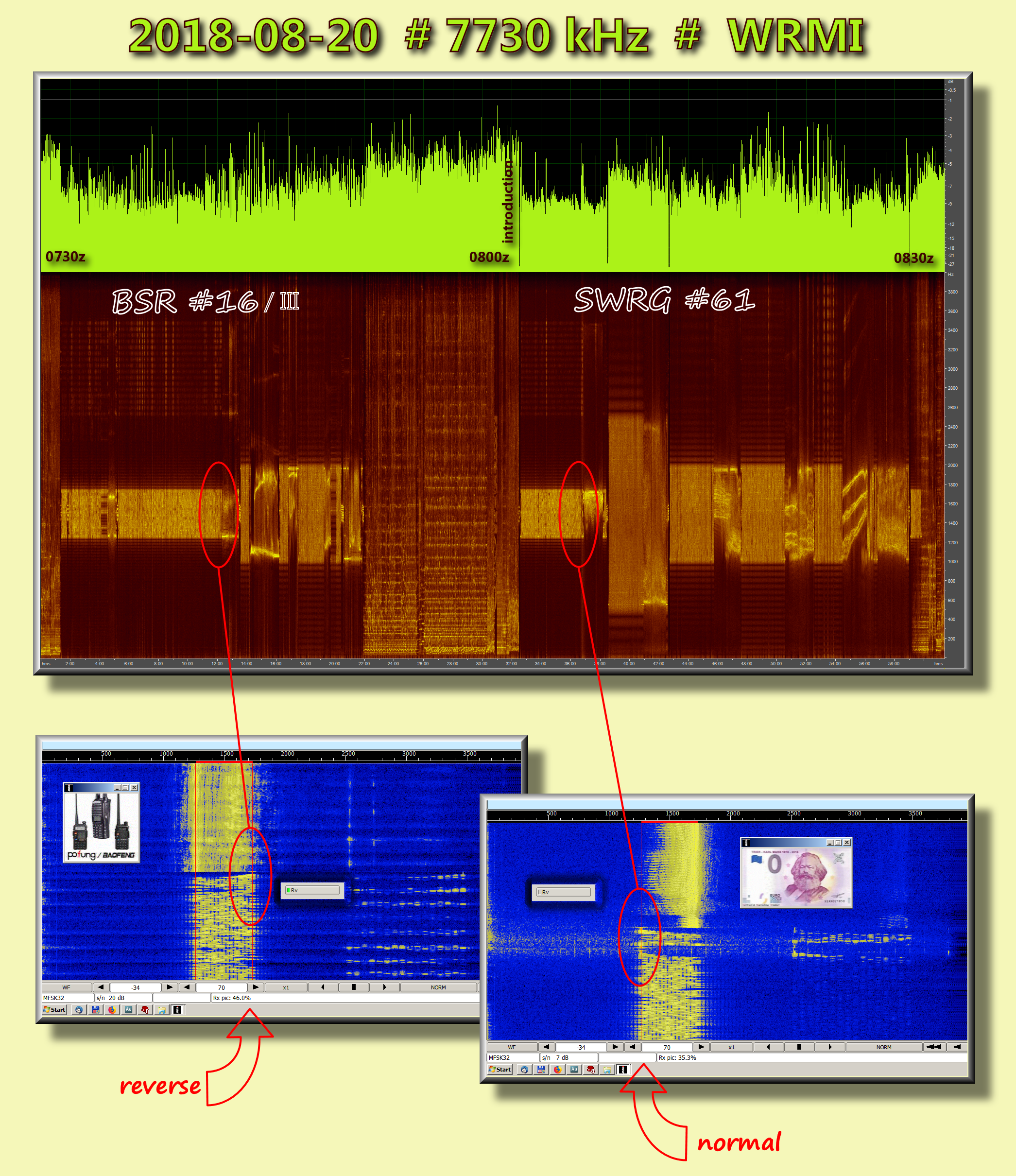
RSID: <<2018-08-20T07:30Z
MFSK-32
@ 7730000+1500>>
Welcome to the BSR Radiogram from BroadSpectrumRadio and KG5JST
Produced by James M. Branum
www.broadspectrumradio.com
August 6, 2018
QSL reports are welcome at
broadspectrumradio@gmail.com
RSID:
<<2018-08-20T07:31Z MFSK-32
@ 7730000+1500>>
RSID: <<2018-08-20T07:31Z MFSK-32 @ 7730000+1500>>
And now it’s time for some commentary, some thoughts from myself about ham
radio. Specifically about its future.
While there are many new hams being licensed each year, it is also true that the
majority of active hams today are getting older and older. Some people, who I
call the grumpy doomsdayers, insist that the problem is cultural in nature, that
younger people are lazy and
unwilling to engage their attention spans in a hobby that doesn’t always reward
quick and superficial efforts.. And then folks insist that the reason that “ham
radio is dying” is because we have lowered the standards, we quit insisting that
everyone learn morse code,
and consequently are stuck with a radio service that is little better than a
glorified form of CB radio.
Well I’m not a grumpy doomsdayer, in part because I think that this hobby is
about to enter into another golden era, as more and more folks, young and old
alike, get tired of being mere consumers of communication technology and instead
want to learn and engage with
it from a DIY hobbyist perspective.
But I do think there are things that our hobby can do, which can make it easier
for new folks to get involved, which is what I want to talk about in this
segment.
I think there are three main obstacles to getting new folks into ham radio,
three hurdles that some will overcome but that also discourage and dissuade way
too many people from getting turned on to ham radio.
These obstacles are: (1) The Test, (2) The Cost, and (3) The technical
challenges.
First, the test…
Sending Pic:100x100C;
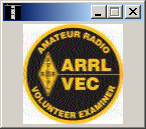
RSID: <<2018-08-20T07:34Z MFSK-32 @ 7730000+1500>>
RSID: <<2018-08-20T07:34Z MFSK-32 @ 7730000+1500>>
This issue is on my mind because I recently took a ham radio licensing exam, at
the annual HamHoliday, a ham radio convention in Oklahoma. I’m currently a
General class operator and I’ve been studying for the Extra class exam, so I
decided to take a shot at it (which
I was given an extra nudge to do so by the kind folks at the SCARS VE Testing
team from the Norman area, who provide the VE testing session free of charge,
rather than charging the customary $15 fee to cover expenses). Sadly I didn’t
pass, but I came close, missing
it by only 2 questions...so I will take it again, probably in September.
But while taking my exam, I got to visit with a fair number of other test
takers, a few folks like me taking Extra class tests, several taking general
class exams, but most taking Technician class exams. Lots of folks left the
testing room, ecstatic in their victory
over the test, but quite a few others left crushed by the experience,
discouraged and convinced that they were “stupid.”
The reality is that the folks who failed the exam are likely good folks who
would be conscientious and thoughtful operators, particularly if they had a good
elmer or mentor to work with them, but the test stands in their way. I’m sure
some of these folks just didn’t
study enough, but I think it is much more likely that many of those who had
failed, had studied their butts off, and are just bad test takers.
The licensing exam exists as a measure of minimal competency, but I wonder if it
really serves that purpose? Some of the test questions are relevant and helpful
but others are irrelevant, confusing or downright esoteric. Surely there could
be a better way to do this.
The ARRL has proposed some options and other commentators have done so as well.
Some ideas being discussed is a revival of the old Novice class, with an easier
entry-level test, as well as expanded HF privileges to Technicians to provide
more early excitement to new
hams. As expected the Grumpy Doomsdayers have attacked these ideas arguing that
this will cheap the hobby, but these folks are missing some key points.
First, there is nothing sacred about our current testing system. It has been
changed in the past and can be changed in the future.
And second, if the test is designed to weed out the problematic operators, it is
failing in this mission, primarily because most of the problematic operators out
there today are folks who have been on the air for decades. I’ve learned that
any time I hear racist
jokes, intentional interference and just general rudeness, it is rarely ever
coming from someone who is a new ham.
And finally, lot’s of folks have test-taking anxiety and many have learning
disabilities. Certainly these obstacles can be overcome by the stubbornly
committed, but these obstacles do push some away altogether and delay others
from entering the hobby.
So I say let’s be creative, let’s rethink the test.
2. The Cost
Ham radio can be done cheaply but it is not easy to do so. VHF/UHF is easier to
pull of on a budget, but HF is something else. What most hams would consider an
entry-level transceiver will run $500-1000. Certainly that is cheaper than what
some spend on their hobbies
but it is not chump change either, and it serves to keep a lot of folks out of
the hobby, not only young people but also retirees on a fixed income, as well as
middle aged folks who are just trying to make ends meet.
The grumpy doomsdayers tend to say “tough cookies,” mostly because they
fundamentally only want folks like themselves in the hobby. And unfortunately
some ham radio organizations and magazines have a conflict of interest on this
issue, since they depend on the
advertising dollars paid by the major equipment manufacturers, to pay the bills.
But this issue has to be addressed. Certainly some hams are very content to stay
with being VHF/UHF operators, focusing on public service in their communities
and chatting with their friends, but many folks, including SWL’s got into ham
radio because we wanted to be
on the shortwaves… we wanted to be heard hundreds of kilometers away, even on
the other side of the globe. So we have to find better ways to make the hobby
more affordable, especially to get on HF.
Which leads us to…
3.The Technical Challenges
As I just mentioned, cost is a barrier to getting into ham radio, and so
beginners have to find affordable entry points.
For VHF/UHF, Baofeng HT’s have been a game changer. The grumpy doomsdayers hate
them, but the reality is that for most hams in major metropolitan areas, the
Baofeng (if equipped with a better antenna, such as a longer Nagoya antenna)
will hit local repeaters, all for
a total investment of under $50. But if you live in a rural area and/or want to
do simplex work, the cheap HT’s can be frustrating. Still I’m glad I ignored the
grumps and started with them.
Sending Pic:150x139C;
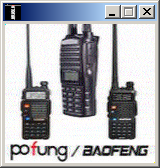
RSID: <<2018-08-20T07:42Z MFSK-32 @ 7730000+1500>>
RSID: <<2018-08-20T07:42Z MFSK-64 @ 7730000+1500>>
As for HF… there aren’t any easy solutions…
The cheapest HF transceivers are kit-built, but this is a big jump for a new ham
to take on, and so most will go with a Multi-mode/Multi-band radio that is
already built. But due to cost constraints, many of us will end up going QRP,
doing what I did and starting
with something like the Yaesu FT-817, a great radio by the way, but one that is
still QRP. On a good day, when the conditions are right, I can talk to someone
on the other side of the country via SSB, but on most days I struggle to be
heard on our local 10 meter net,
with the control operator being about 12 miles away. Of course, some insist that
CW is the only answer, but let’s be frank. Morse code is hard to learn and hard
to effectively operate.
Sending Pic:250x155C;
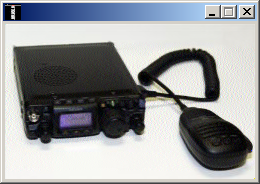
And what other options are there?
Remotes? --- Yes, they can be fun (I’ve used the ones from both
Remotehamradio.com and RCFORB) but
in most cases they are not cheap and frankly they are not as much fun as running
your own radio.
Thankfully two recent developments have helped to provide some hope for
financially challenged hams.
First, there are the weak signal digital modes, especially at this moment FT-8.
I know the grumpy doomsdayers hate these modes, but I love them. To actually
make cross-country and even DX contacts on 5 or less watts power, on a
consistent basis, is unbelievably
awesome…. It’s still not easy, but it is much, much easier than QRP SSB.
Sending Pic:200x200;
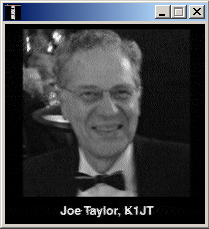
But secondly there are the new SDR
transceivers, some of which are kit built, but I hope in time will also be
available in pre-built and/or easily-assembled forms.
So… there’s hope.
What I want to close with is directed at any new hams out there, folks who have
passed their technician class exams but are considering their next steps, but
also for any SWL’s, shortwave listeners who are nervous about taking their exam…
I want to share some things that I wish someone had told me a few years ago,
when I was first starting in this crazy adventure…
1. Go cheap for VHF/UHF. --- Start off cheap. You can always get a fancier radio
down the road if you fall in love with VHF/UHF, but for now buy the cheap
Baofeng, Wouxun, etc. And don’t believe the grumps out there… they may not be
perfect, but they get the job
done.
2. But when you go cheap, be smart about it. --- The stock antenna on many
Baofengs is crap. I don’t know why, but these antennas are called rubber duckies,
and they are worthless. Instead spend $10 or so and get a better antenna, such
as a Nagoya. Also you’ll want
to spend another $10 to get a programming cable, so you can use the CHIRP
software to program your radio with all of your local repeaters.
3. Speaking of programming those Baofengs --- Most will let you program the
frequencies for NOAA weather radio, trains, GMRS, MURS, FRS, etc. Obviously you
can’t legally transmit on these frequencies, but you can listen (at least here
in the USA).
4. For HF, go cheap on antennas --- Seriously, a dipole wire antenna can do
wonders. Building your own is very do-able. But… you likely will need a tuner.
There are high priced ones out there, but you can find them new for under $100
from MFJ or used for even less
(my current tuner I got for $50 used).
4a. Batteries
5. For the transceiver --- No easy answers here. I love my Yaesu but I paid too
much for it. If I was starting new today, i would probably look at one of the
SDR-based kit builds.
6. For digital modes --- I’ve heard good things about the Signal Link and other
interfaces, but I ended up going with something much cheaper, the Wolfilink. It
is designed to link up a cell phone or tablet to a transceiver but with the
right audio cables and splitter
it can connect with a computer.
Sending Pic:200x125;
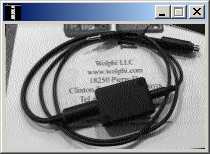
7. Be patient and set your own goals
--- Unless you are lucky and can afford a 100 watt radio right away, you can’t
judge yourself by comparing yourself to others. Instead set your own goals.
That’s it for this week.
Don’t forget, QSL reports are welcome at
broadspectrumradio@gmail.com.
And keep an eye out for this special event station, W5G:
RSID:
<<2018-08-20T07:49Z MFSK-64
@ 7730000+1500>>
RSID: <<2018-08-20T07:49Z MFSK-64 @ 7730000+1500>>
Sending Pic:300x227;
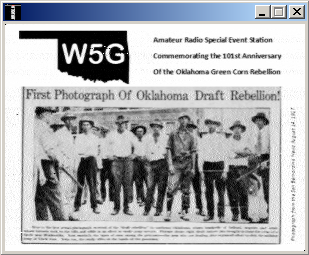
RSID: <<2018-08-20T07:51Z MFSK-64 @ 7730000+1500>>